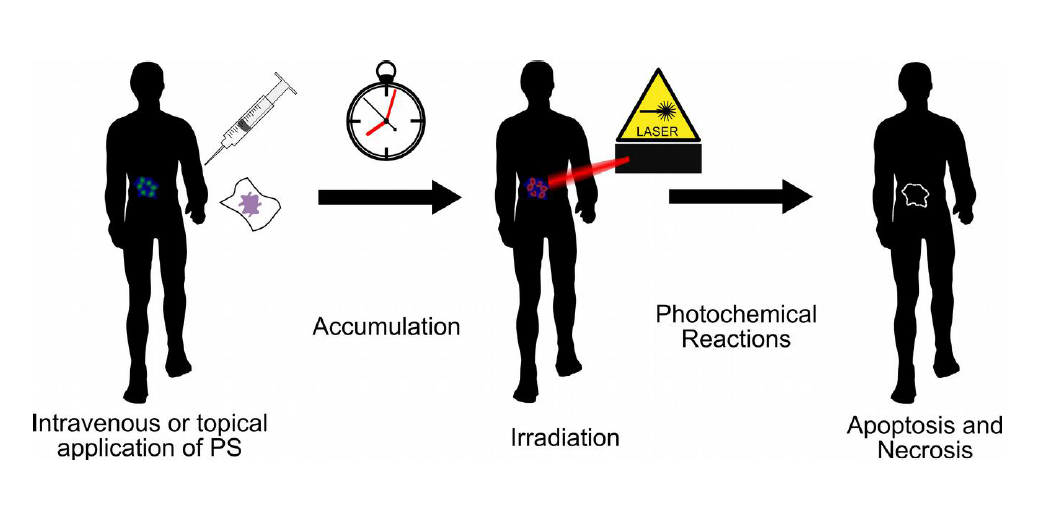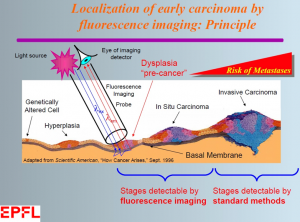Our research is mostly focused on the use of light to detect and treat conditions corresponding to important socio-economic concerns, including cancers, and to characterize biological tissues. Our projects centered on photomedicine are integrating in vitro, preclinical and clinical studies. Many of our projects are applied and translational, leading to clinical tests and introduction into the market. Therefore, they require close collaborations with numerous academic, clinical and industrial partners. Convinced by the fact that academic and industrial development can lead to new detection and therapeutic approaches, we establish, as academic partner, the link between the clinical and industrial worlds. Our “from bench to bedside” policy leads to significant contributions to the development of approved drugs and equipments.
Most of our projects are in the fields of cancer photodynamic therapy (PDT) ( Figure-1) and photodetection by fluorescence imaging ( Figure-2 ). These approaches are based on the administration of a tumor localizing phototoxic and/or fluorescing dye, which is used for the destruction and/or detection of the lesion. PDT takes advantage of the dye phototoxicity and selectivity by irradiating the treated area with spectrally adapted and controlled light doses. Photodetection is performed by illuminating the investigated area with excitation light that induces the dye fluorescence in the cancerous lesion. In certain organs, the tissue native autofluorescence is bright and contrasted enough to enable the detection of superficial cancerous lesions.
A preliminary screening of these photosensitizers and fluorescing agents requires the study of their spectral features. These studies involve the determination of their fluorescence quantum yield, fluorescence lifetime, fluorescence and absorption spectroscopy, photobleaching properties, singlet oxygen production yield and phototoxicity.
We are also working on the study of fundamental mechanisms involved in photobiomodulation (PBM) or low level light therapy (LLLT) for their optimization and for the development of novel applications.
Finally, tissue optical parameters such as the excitation wavelength dependence of the autofluorescence spectrum, and the absorption and scattering coefficients, are essential to the modeling and optimization of PDT, PBM and photodetection. Consequently, we are performing ex and in vivo measurements of animal and human tissue optical properties.

Figure 1 : Principle of photodynamic therapy

Figure 2: Principle of cancer detection by fluorescence imaging
Expertise
- Detection of early cancers by fluorescence imaging and spectroscopy (See for instance the FDA approval of the drugs Cysview® and Hexvix®, co-developed and optimized with Photocure and IPSEN, as well as the fluorescence endoscope DAFE developed with Richard Wolf GmbH)
- Characterization of superficial (pre)cancers by high magnification endoscopy
- Measurement of the tissue oxygen concentration by time-resolved luminescence lifetime spectroscopy and imaging
- Preclinical and clinical study of photosensitizers for photodynamic therapy of cancers and non-cancerous conditions including age-related macular degeneration
- Photodynamic drug delivery
- Treatment of neurodegenerative diseases and other conditions associated with tissues hypoxia by photobiomodulation
- Optical spectroscopy of photosensitizers
- Radiometry, light delivery and dosimetry
- Tissue optics and optical spectroscopy